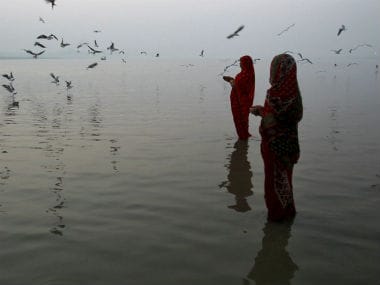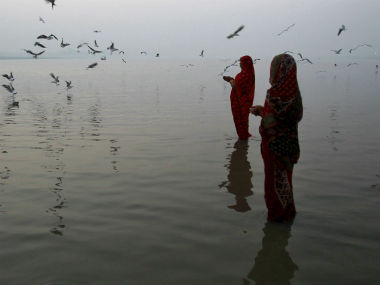A 500-acre facility to breed freshwater turtles in Uttarakhand ought to be good news. I for one ought to be jumping with joy. But I’m not and here’s why. On Aug 20, an IANS news release said the state’s Chief Minister, Harish Rawat, had approved a turtle breeding facility in Rishikesh. The scavengers will then be released in the River Ganga. The 2,400-kilometre-long holy river carries not only the ashes of cremated bodies but partly burnt ones, carcasses of animals, sewage from every town and city along its course, as well as industrial effluents. The news report says 400 crematoriums will be built to take care of the many dead, but the turtles will have to deal with the rest. “These animals have a natural mechanism to rid the river of pollutants,” says an official. Who is he, which organisation does he represent, and what is his expertise? Unknown. [caption id=“attachment_2806602” align=“alignleft” width=“380”]  Representational image. Reuters[/caption] Over the years, state pollution control boards conducted surveys to find and fine the polluters. As many as 764 industrial units such as sugar refineries, distilleries, pulp and paper industries, and tanneries, discharge 500 million litres per day of mostly toxic waste into the river and its tributaries, Kali and Ramganga. Some cities have waste treatment plants but they are not adequate. Local municipalities have no money to run these plants, while others don’t have any treatment plants. No government has succeeded in reducing pollution. And yet, they want a bunch of turtles to fix the problem. This is not a new initiative. The first river clean up program was launched in 1986. A year later, the Centre and the state governments funded a program to breed turtles. They took eggs from wild nests on the sandy banks of the River Chambal and incubated them at centres in Varanasi and Kukkrail, near Lucknow. After the hatchlings of the Indian peacock softshell, Indian flapshell and Indian softshell emerged, they were reared for a year and released in the Ganga at Varanasi. Barring a gap of 12 years between 1993 and 2005, nearly 35,000 tiny cooters swam to freedom. What did this operation achieve? We don’t know but it won’t be a surprise if it didn’t amount to much. The authorities didn’t track the turtles after release and their fates are unknown. But the state of the river has only worsened. The dinner-plate-sized Indian flapshell is a survivor and arguably the most widespread and common turtle in the country. It lays up to 14 round eggs in a nest cavity along river banks, ponds, rice fields, canals, and even septic tanks. It eats anything from water plants to insects to carrion. The metre-long Indian softshell turtle is also a glutton and lays up to 35 eggs three times a season. And the third candidate, the peacock softshell turtle is even more fecund, laying up to 40 eggs each time on multiple occasions throughout the nesting season. These are not delicate species that need a specialised environment to breed. While they may be able to survive the organic effluents, they cannot deal with the chemicals being poured into the river. And unless this is controlled, it’s unlikely any life can survive in the river. If the river is a moving feast of corpses and plants, these creatures ought to thrive with no help from humans. And yet they do not. All these turtles were indiscriminately slaughtered until the 1980s for the meat markets of Bengal. When hunters mopped up the local rivers and streams of its turtles, contractors went as far up as the Punjab to meet consumers’ appetites. Experts then estimated that 50,000 to 75,000 Indian flapshells, 7,000 to 8,000 large softshells, and at least 10,000 to 15,000 hardshell turtles were sold at the Howrah market in Calcutta annually. When the plight of these turtles hit the news, they were protected by the Wildlife Act. Much of the trade was shut down over time, but a fraction of it went underground. Each year, reports trickle in of crime sleuths arresting poachers. In March this year, 52 turtles were found caught in a net, only 10 survived. The arrest of two poachers is August last year busted one of the largest smuggling rings. In another instance, 123 confiscated turtles were returned to the wild in November. According to statistics maintained by the Wildlife Protection Society of India, 3,800 softshell turtles were confiscated in 2015, over 8,000 in 2014, and more than 5,000 in 2013. Bengal, the main local turtle market, is downriver from Varanasi. The belly plate of turtle shells are dried and several crammed into jute bags to be smuggled to China and Southeast Asia. Is there any guarantee that these captive reared turtles will not feed the smugglers’ racket? Poaching is just part of the problem. In Chambal, sand miners scoop out sand where gharial and turtles make their nests. This is the source of not only the wild populations, especially of Indian softshell and peacock softshell, but the futile turtle breeding operations in Varanasi and Kukkrail. If the nesting habitat is destroyed, poachers are hammering the adults, and any eggs moved to breeding facilities that have no proven success, what will become of the wild populations? Estimates of the Ganga clean up since its inception range from Rs 4,000 crores to 20,000 crores. How much of it funded the turtle program? Probably not a lot. In May 2015, the Modi government sanctioned another Rs 20,000 crores for the Namami Ganga project. Over the past two years alone, it spent Rs 2,958 crore although there is little to show for it. In the meantime, the Minister for Road Transport, Highways, and Shipping, Nitin Gadkari, thinks the clean up may actually cost Rs 80,000 crores. If all the zeros are confusing, that’s about $11 billion. Unless there is a monitoring program that assesses whether hand-reared turtles in the still waters of breeding facilities can survive the toxic sludge that is the Ganga, at least one component of the program is doomed to be a failure.
If the Ganga river is a moving feast of corpses and plants, these creatures ought to thrive with no help from humans.
Advertisement
End of Article


)

)
)
)
)
)
)
)
)



